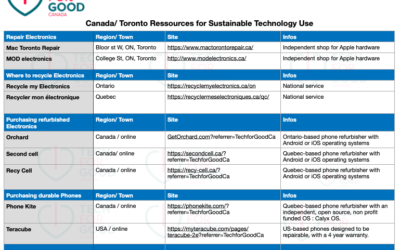How do you do distance learning right in primary and secondary schools in Canada?
This was the topic of an hour and a half long discussion Tech for Good Canada convened with Canadian elearning researchers and educators this Tuesday, June 23 rd, 2020. Given the very mixed record of schooling in most of Canada’s public schools during Covid-19, what is at stake is whole cohorts’ mental health and intellectual development.
See a 12 minute excerpt below.
Brutal Switch to Distance Learning in Sparing 2020 Doesn’t Mean Schools shouldn’t Prepare for the Future
When Canadian teachers suddenly had to stop teaching in person and kids in grades K to 12 stayed home, very few educators were equipped with the training required to sustain learning efficiently for their students.
Even if school is able to be held in person again in the fall, it will most likely be in diminished mode, thereby negatively impacting students. Focusing time and efforts on the logistics of distancing and hand washing takes away precious resources that could be used to train educators.
In addition, turning to online learning backed by pedagogical best practices could help Canadian schools leap towards a more equitable and efficient system, one that would make them competitive with private companies looking at education as yet another market to enter and « disrupt », with profit-making as the only motive.
This is completely understandable. What is inacceptable is not leveraging excellent skills and knowledge in our universities and schools to help convert thousands of teachers across Canada, notably Ontario, to proficient distance teachers.
Children’s Mental Health is the Cost of Poor eLearning Pedagogy
What’s at stake, if teacher unions remain opposed to synchronous learning and governments like the one in Ontario focus on the number of video sessions a teacher must hold each day, as a replacement for research-based efficient elearning techniques? Simply a cohort of students ‘ mental health and intellectual capabilities. And down the line, what is at stake are increased inequalities among youth and a loss of sovereignty for Canada, when private foreign online players persuade parents who can afford it to sign up to their online learning programs for their kids.
Some of the points that came out of our open discussion with Professor Janette Hughes, of Ontario Tech University, Jason Lay, high school teacher and MBA, Jeff Cummings, high school teacher and internal technology learning consultant to teachers, and Jono Landon, a past educator and Ed tech entrepreneur, CEO of Hubbli:
Rethinking Pedagogy for Online Learning
Distance learning must be thought of with pedagogy in mind first, said Jeff Cummings. Technology is only an enabler for that pedagogy.
Not being in the same room does require rethinking pedagogy, however. A flipped classroom approach is one that works best, according to Canada Research Chair in Pedagogy and Technology Dr. Janette Hughes.
This entails giving students material to cover on their own- in a digestible format for the young ones, including videos and short text, making them work on projects in groups, and using the synchronous moments for discussion with the teacher only. No lecturing for hours behind a screen is going to help kids engage with material. Teachers should welcome this news, as engaging with students is probably what they like to do best.
What this flipped pedagogy means, however, is rethinking the content provided to students. Long texts and printed worksheets probably will not work. Videos, quizzes, projects should get a better reception.
Synchronous/Asynchronous: Addressing Students Differently according to Their Needs
What about those students with special needs or whose personal circumstances make it difficult to access or focus on class material ? They should be managed separately, by qualified staff. Removing all online tools because a minority cannot access it makes no sense for youth well-being. Leaving no one behind is essential, however.
Providing various options for students to access material is another recipe for success, said Jason Lay. For some students, he offered synchronous lessons, that he recorded so that the others (a majority) could watch them asynchronously. He also offered various ways to communicate. While some used Google Classroom, others preferred email, or others comments in a Google document.
Jono Landon indicated most of the private schools he deals with as clients quickly adapted to online teaching, to make sure they justified parents’ enrollment fees.
Choosing a Learning Management Systems ( LMS) and Training Teachers
The issue of what technologies to use came up. Learning Management systems like Blackboard ( by D2L) and Google Classroom became necessary to communicate with students and parents. Janette Hughes uses her own, as she finds these LMS ’s poorly address the social aspect of teaching. Jeff Cummings highlighted the privacy ensured by D2L, a global, Canadian company that strictly abides by privacy laws in Canada, Europe and the US and is offered in Ontario boards.
Jason Lay indicated many teachers migrate to Google Classroom, however, because it includes the suite of applications ( documents, spreadsheets, presentations and forms) and even if it not as feature -rich as D2L’s offering, it has an easy learning curve- not to mention being familar from search for teachers.
Privacy issues with Google Classroom remain a major concern for students’ and teachers’ data. The tool made available free to schools is also a Trojan Horse to get thousands of future adult users to its services, without parents’ explicit consent. Google is sued accross America and Europe for its privacy practices.
What is coming through in qualitative results from Tech for Good Canada’s ongoing survey of parents is the disparity of tools used by teachers and the confusion that often causes for parents and students. Jason Lay indicated in the case of Ontario, guidelines were late in coming — June 22nd- despite many international examples to emulate- and were very vague, leaving individual school boards to improvise. All this as summer is here and teachers expect a well-deserved rest. He added that the challenge will be even higher in the fall, when teachers will welcome new students in their classes.
Jeff Cummings, who was part of the team of internal technology learning consultants for his board before returning to teaching, took it upon himself to assist his fellow teachers in learning the ropes of efficient distance learning. We heard many stories of teachers stepping up to help their peers during the March to June period.
Are Students’ Smartphones a Tool to be Used in Teaching ?
A heated debate occurred about smart phones, the « weapons of mass distraction » for some, that entered classrooms 10 years ago without asking. Jono Landon was adamant about their unessential role in class. Janette and Jeff argued if a teacher is trained in working with them — such as letting teens check them at regular intervals, and using them in the pedagogy, they can play a beneficial role. In my opinion, the jury is still out, with a number of schools in the US and Europe having opted to remove phones for students during class time altogether.
Training Teachers for Online Pedagogy is Urgent
If students are to succeed and return to good mental health and Canada to thrive, it needs to focus on leveraging the skills of teachers who do master distance learning and of the researchers who have been practicing it and performing research on it for over twenty years.
A major push towards emergency professional development in this area for all teachers is needed. A focus on how many hours of video calls or how many bottles of hand sanitizer should be available in schools in the fall will hurt students, educators and all citizens in the end.
Find a full description of the event and speaker bios here: Canadian Schools and Distance Learning during Covid19 – June 23rd, 2020







